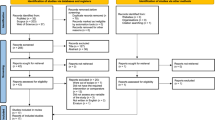Summary
Ninety-six boys aged 11–13 years were tested at submaximal and maximal loads on a bicycle ergometer. Submaximal and maximal heart rates and maximal oxygen uptake were measured. A function predicting \(\dot V\operatorname{O} _{2\max } \) from age, height, and steady state heart rate at submaximal work load was developed using multiple regression analysis.
Similar content being viewed by others
References
Astrand PO, Ryhming I (1954) A nomogram for calculation of aerobic capacity (physical fitness) from pulse rate during submaximal work. J Appl Physiol 7:218–221
Astrand I (1960) Aerobic work capacity in men and women with special reference to age. Acta Physiol Scand [Suppl 49] 169:1–92
Astrand PO, Rodahl K (1970) Textbook of work physiology. McGraw-Hill, New York
Davies CJM (1968) Limitations to the prediction of maximum oxygen intake from cardiac frequency measurements. J Appl Physiol 24:700–706
Döbeln W von, Astrand I, Bergström A (1967) An analysis of age and other factors related to maximal oxygen uptake. J Appl Physiol 22:934–938
Gürses Ç (1978) 11–13 YaŞ Grubundaki Çocuklarda Antrenmanin Aerobik Performans Kapasitesine Etkisi. (The effects of exercise training on aerobic performance capacity in children 11–13 years of age). Doctoral Dissertation, University of Istanbul
Gürses Ç, Binyildiz P, Gökhan N (1978) ÇeŞitli Antrenmanlarin Oksijen İleti Sistemi üzerine Etkisinin 11–13 YaŞ. Grubu Çocuklarda İncelenmesi. (The effects various training methods on oxygen transport system in children 11–13 years of age). Turkish Scientific Research Council TAG 338, Istanbul
Fox EL (1973) A simple accurate technique for predicting maximal aerobic power. J Appl Physiol 35:914–916
Lindemann H, Rutenfranz J, Mocellin R, Sbresny W (1973) Problems of indirect determination of maximum oxygen uptake. Eur J Appl Physiol 32:25–53
Margaria R, Aghemo P, Rowell E (1965) Indirect determination of maximal O2 consumption in man, J Appl Physiol 20:1070
Maritz JS, Morrison JF, Peter J, Strydom NB, Wyndham CH (1961) A practical method of estimating an individual's maximal oxygen intake. Ergonomics 4:97–122
Musgrave J, Dore C (1974) A nomogram for the calculation of oxygen uptake. J Appl Physiol 36:606–607
Neyzi O, Binyildiz P, Alp H (1978) Türk Çocuklarinda büyüme — geliŞme normlari. İst Tip Fak Mecm [Suppl 74] 41:1–21
Nunn JF (1972) Nomograms for calculation of oxygen consumption and respiratory exchange ratio. Br Med J 4:18–20
Wilmore JH, Sigerseth PO (1967) Physical work capacity of young girls, 7–13 years of age. J Appl Physiol 22:923–928
Author information
Authors and Affiliations
Rights and permissions
About this article
Cite this article
Binyildiz, P.O. Prediction of maximal oxygen uptake in boys 11–13 years of age. Europ. J. Appl. Physiol. 43, 213–219 (1980). https://doi.org/10.1007/BF00421834
Accepted:
Issue Date:
DOI: https://doi.org/10.1007/BF00421834




